Study Triggers, User Filters and Group - Depricated
Triggers
A trigger is an event used to initiate the display of a study to a visitor. Click on your study, and you can configure the trigger in the Audience tab.
Info
For Web and Mobile surveys to trigger, make sure you have decided how to implement that event prior to defining the Audience portion of your study. For Web you can add Events via No Code or Code. For Mobile use Code events.
Select an Event to Trigger
- Navigate to a study.
- Select the Audience tab of the study.
- Choose either Web or Mobile App as the delivery method.
- Navigate to the When to Send.
- Click Select... and scroll or type the event name that is intended to display the study to your customer, then select that event.
Additionally, you can choose if you'd like multiple events to be eligible to trigger the study, and you can also set time delays between when the visitor performs the action and when the study is displayed.
Select Multiple Triggers
Sprig supports up to 10 triggers per in-product study. To add additional triggers, click Add Another Event.
Set Time Delayed Triggers
You can set a time delay on Web and Mobile before displaying the study.
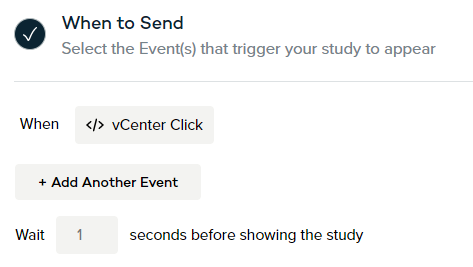
Select Event Properties
You can add event properties to Code events for Web and Mobile studies. Sprig supports filtering up to 10 total event properties across all triggers in a study. For example, if your web study is configured with 2 triggers, you can have 5 event property filters across each.
Click Select Event and scroll or type the Code event name that is intended to display the study to your customer, then select that event.
Click on the Apply event properties icon and scroll or type the event property name you wish to use.
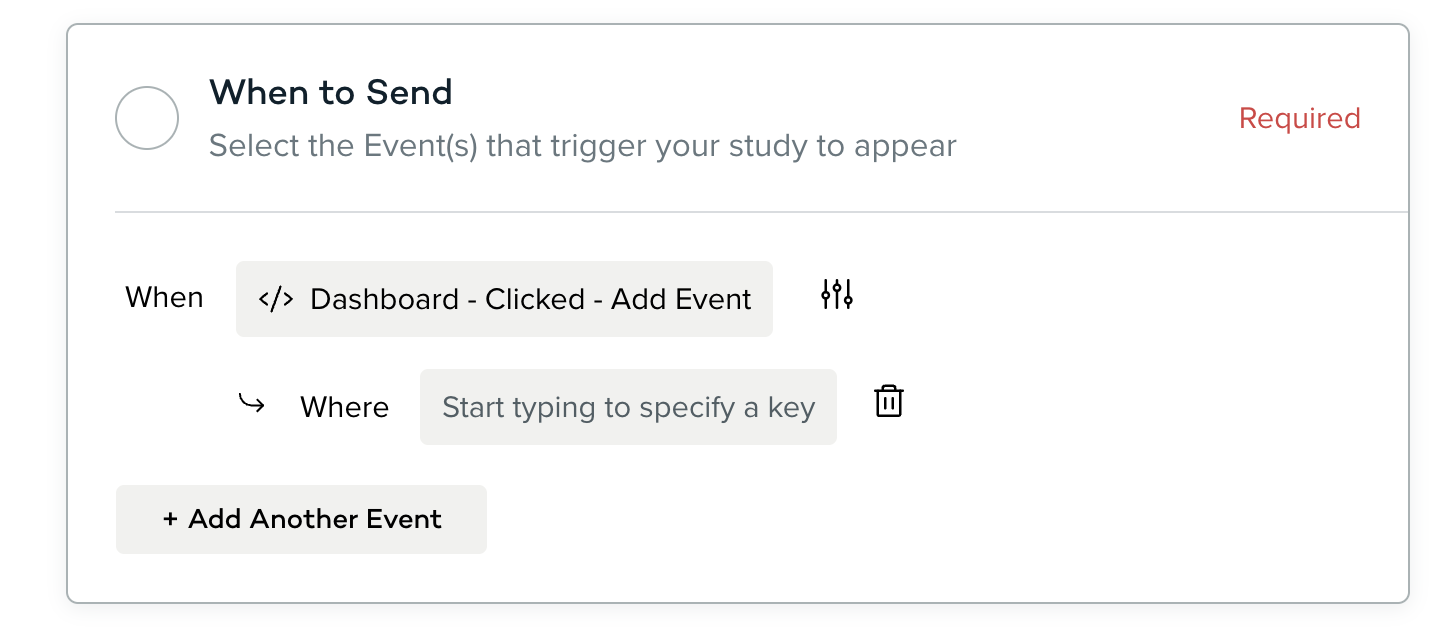
Study Filter
Study Filters are useful when you want to segment the audience that should qualify for a study. A study's filter can be either an Event , an Attribute , or a Group . There are also two predefined Study Filters, one based on the number of times or sessions the user has visited the site and the other on the number of pages the user has seen during the current session. You can use Study Filters for Web and Mobile studies.
Select Filters
- Navigate to a Study.
- Click the Audience tab of the study.
- Choose either Web or Mobile App as the delivery method.
- Navigate to Who to Send to. Click + Add Filter.
- Click the Events, Attributes, or Groups tab, then select the appropriate item.
- To learn more about active the event, attribute is, hold the pointer over
 diagnostics in Usage.
diagnostics in Usage.
If the diagnostics is grey , your event or attribute has not been updated within the last week. If the diagnostics is green
, your event or attribute has not been updated within the last week. If the diagnostics is green  , your event or attribute has been active within the last week.
, your event or attribute has been active within the last week.
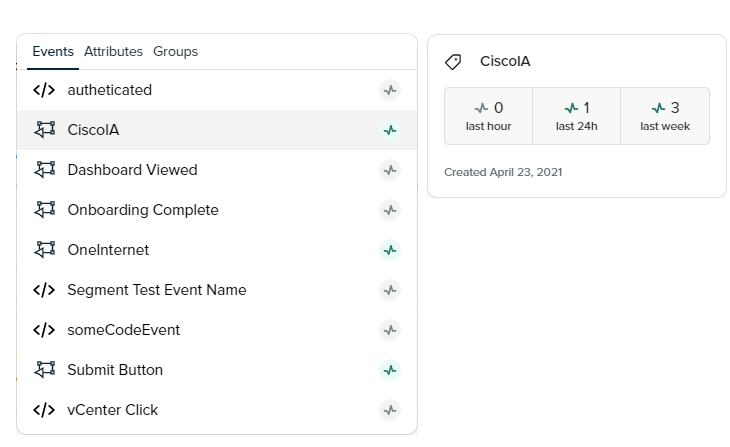
Sessions as Filters
Sessions and Page Views as Filters
- Select Advanced from the dropdown for filters.
- Choose the Session check box.
- Input a number to represent the number of sessions you'd like the study to wait before a given user can experience it.
Info
Sessions in Sprig are measured as 12-hour windows in which a visitor has one or more events tracked.
Page Views as Filters
- Select Advanced from the dropdown for filters.
- Choose the Page check box.
- Input a number to represent the number of pages you'd like the study to wait before a given user can experience it.
Info
Page views are only applicable to web studies and will not be displayed for mobile or link-based studies.
Events as Filters
When you select an event as a study filter, you will need to specify the condition that triggers the event. For example, the following shows a condition of BrowserLang = en-US.
| Filter | Value | Use |
|---|---|---|
| Is Set | Yes or No | The Is Set operator checks whether or not there is a value stored for the intended event |
| Occurrences | Is greater than, Is less than , is greater than or equal to , is less than or equal to , is equal to | The Occurrences operator compares the total number of times an event has been triggered by a visitor, since first being tracked, to the specified value provided by the user |
| First Occurred | Is greater than, Is less than , is greater than or equal to , is less than or equal to , is equal to | The First Occurred operator compares the first recorded event trigger and compares to the value specified by the user |
| Last Occurred | Is greater than, Is less than , is greater than or equal to , is less than or equal to , is equal to | The Last Occurred operator compares the last recorded event trigger and compares to the value specified by the user |
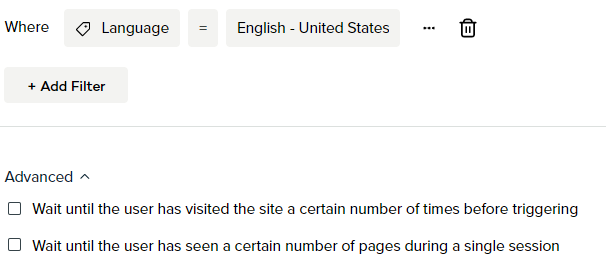
Event/Attribute Study Filters
Attributes as Filters
Like events, attributes are just another way to enhance your study targeting functionality. While events are triggered by behaviors that occur on the client-side, attributes can be thought of as groups or segmentations that are assigned based on that client-side behavior.
Included Attribute Conditions:
is equal tois not equal tois setis greater thanis greater than or equal tois less thanis less than or equal to
Sprig does not support DATE or DECIMAL data types. All non-supported data types are converted to strings. The logical operators supported for Strings are equal, not equal, and is set.
Groups as Filters
Groups can also be used as filters.
Included Group Conditions:
users in groupusers not in group
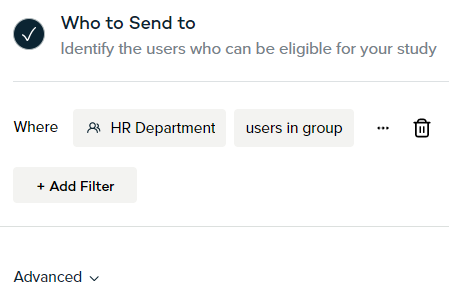
Group Study Filters
AND/ORs
AND/ORs allow for increased functionality when targeting user cohorts. Conditions with AND must satisfy all criteria, whereas conditions with OR only need to meet one.
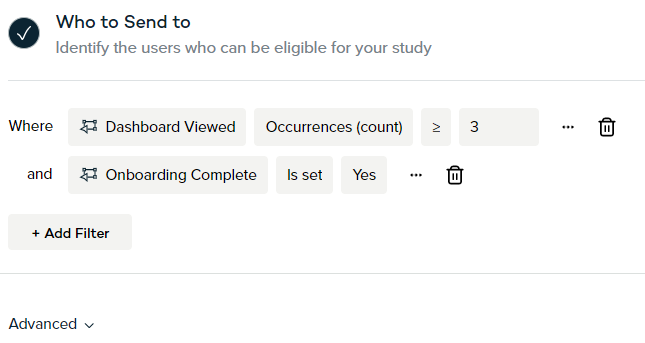
Logic Groups
Logic groups allow you to create more complex groupings of ANDs/ORs. For a study to be delivered it must pass at least one of the logic groups. To add a logic group, click ... and select Add Logic Group. Then select the Event or Attribute you wish to add to the Logic Group.
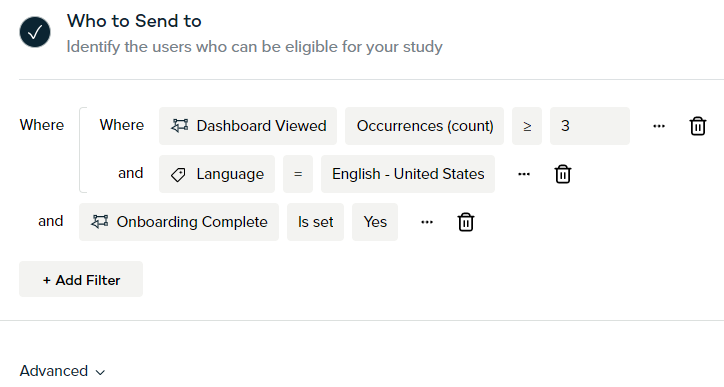
Deleting Logic Groups or Filters
To remove a logic group or a filter, click ... and select Remove.
Insert New Below
Click ... and select Insert New Below to add another study filter below the current filter. Doing so in a logic grouping will add an additional condition within that same logic group.
Groups
Groups allow you to consistently and persistently segment visitors across multiple studies. Instead of configuring each study individually to target a specific audience, you can configure one group filter to target a cohort of respondents and share the group across multiple studies.
Creating a Manual Group
Manual groups are a static collection of users.
- Click Users > All Usersin the Navigation Pane.
Option A: Add to New Group
- Click the checkboxes to select the Users you want to add to the Group.
- Click Add to Manual Group.
- Click Create Manual Group.
- Type in a Name and Description.
- Click Create Manual Group.
- Click X.
- Click the Groups tab to view your newly created group.
Option B: Add to Existing Group
- Click the checkboxes to select the Users you want to add to the Group.
- Click Add to Manual Group.
- Select the Group or Groups you want to add the Users to.
- Click Add to Group
- Click the Groups tab to view your group.
Option C: Adding from CSV file
- Click Upload CSV.
- Select the file you want to upload.
- Select the column that you want to map to User ID.
- Check Add users to Group after uploading.
- Click Continue.
- Select a group to Add to an existing group or click Create Manual Group to add to new group.
- Click Add to Group.
- Click
 Refresh to check if validation is complete.
Refresh to check if validation is complete. - Click X.
Editing Manual Group
- In the Sprig app Navigation Pane, click Users.
Option A: Remove from existing Group
- Click the Groups tab.
- Select the Group you want to remove Users from.
- Click the checkboxes to select the Users you want to Remove.
- Click Remove from Group.
- In the confirmation dialog, click Remove from Group.
Option B: Add to Existing Group
- Click the checkboxes to select the Users you want to add to the Group.
- Click Add to Manual Group.
- Select the Group or Groups you want to add the Users to.
- Click Add to Group
- Click the Groups tab to view your group.
Creating a Dynamic Group
Dynamic groups are a collection of users defined by a Filter. The collection of users who are a member of the group can vary over time, based on the filter.
- In the Sprig app Navigation Pane, click Users.
- Click Filter Users.
- Click Add Filter to create a condition for Users admittance to the group, for example,
Language = French. - Click Apply Filter to view the results of the filter on the current set of Users.
- Click Create Dynamic Group if you are happy with the results of the filter. Otherwise, edit the filter.
- Type in a Name and Description.
- Click Create Manual Group.
- Click the Groups tab to view your newly created group.
Editing a Dynamic Group
- In the Sprig app Navigation Pane, click Users.
- Click the Groups tab.
- Select the Group you want to edit.
- Click Filter Users to view the filter configuration.
- Click
 , to remove or add to the filter.
, to remove or add to the filter. - Once you have finished editing, click Save Changes.
Viewing members of a Manual Group
To view the members, click on the desired Manual Group. The population count shows the number of members in that group. To view more information and the activity of a member, click on that member.
Viewing members of a Dynamic Group
The Dynamic Group Population count shows an estimate of the number of Users that meet the eligibility criteria of the Filters. The value is calculated by sampling a small percentage of Users and extrapolating.
To view a sample of the members of a Dynamic Group, click on the desired group. To minimize performance issues, the display is limited to 1000 Users. Some members may not be shown the table or shown in search results. However, study analysis using Dynamic Groups does not have the 1000 Users limit. All Users who meet the eligibility criteria will be included in the study analysis.
Editing Details of a Group
- Locate the Group of interest; then click
 and select Edit Details.
and select Edit Details. - Update the Name and Description.
- Click Save Changes.
Duplicating a Group
- Locate the Group to duplicate; then click
 and select Duplicate.
and select Duplicate. - Update the Name and Description.
- Click Create Manual Group or Create Dynamic Group. Depending on Group type, only Create Manual Group or Create Dynamic Group will be visible.
Deleting a Group
- Locate the Group to delete; then click
 and select Delete.
and select Delete. - Click Delete Group. Only Groups that are not in use by other Studies may be deleted.
Updated 11 months ago
